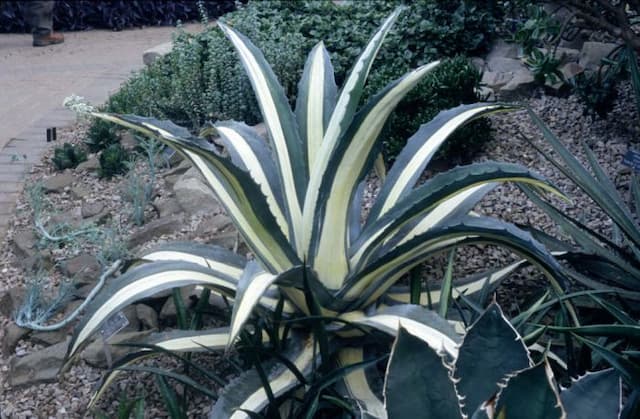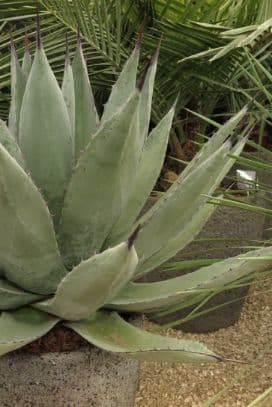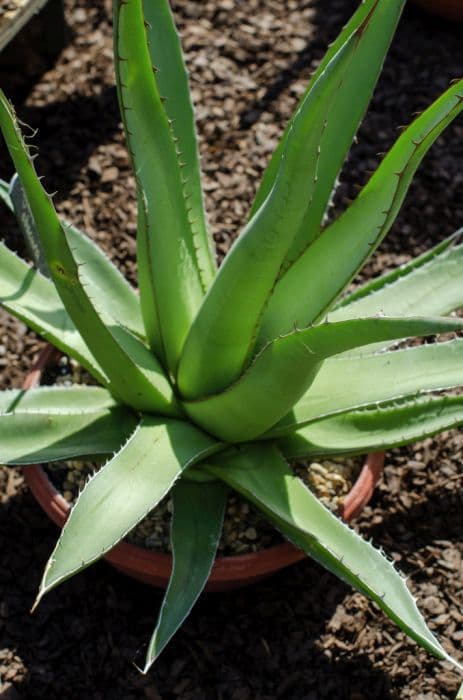Pretty Face Triteleia ixioides 'Starlight'

ABOUT
The Starlight plant, known commonly as Golden Brodiaea, has a captivating appearance characterized by its distinct flower structure and vibrant colors. It produces umbels of dainty, star-shaped flowers that typically come in a charming shade of yellow, which can sometimes have a golden or creamy hue. Each individual blossom is comprised of six pointed petals, arranged in a symmetrical manner, surrounding a smaller set of reproductive structures in the center. These flowers emerge from slender, grass-like foliage that provides an understated backdrop to the floral display. The leaves are usually a bright green, long and narrow, arching gracefully from the base of the plant. The contrast between the delicate flowers and the linear leaves creates an attractive visual dynamic that adds to the ornamental appeal of the Starlight. While in bloom, the plant can create a picturesque scene, as the flowers tend to rise just above the foliage, forming clusters that visually stand out from the greenery beneath them. The overall effect of the Golden Brodiaea's features is of a refined and elegant plant that adds a touch of wilderness and natural beauty to any garden setting where it is cultivated.
About this plant
 Names
NamesSynonyms
Prettyface, Tritelieia, Golden Brodiaea
Common names
Brodiaea lutea, Brodiaea starlight, Hookera ixioides, Triteleia lugens.
 Toxicity
ToxicityTo humans
Pretty Face (Triteleia ixioides 'Starlight') is not commonly listed as a toxic plant to humans. However, most plants have the potential to cause some discomfort if ingested, due to the natural compounds they produce. It's important to practice caution and avoid ingesting parts of this or any garden plant unless it is known to be safe for consumption. If someone were to eat parts of the Pretty Face plant and then experienced unusual symptoms, it would be wise to seek medical attention.
To pets
Pretty Face (Triteleia ixioides 'Starlight') is not widely reported as a toxic plant to pets such as dogs and cats. Nonetheless, pets should not be encouraged to eat ornamental plants, as they can sometimes have unpredictable reactions or the plants could contain substances that are mildly irritating or harmful upon ingestion. If a pet does consume part of the Pretty Face plant and displays signs of distress, discomfort, or poisoning, such as vomiting, diarrhea, or unusual behavior, it is recommended to consult a veterinarian promptly.
 Characteristics
CharacteristicsLife cycle
Perennials
Foliage type
Deciduous
Color of leaves
Green
Flower color
Yellow
Height
1-2 feet (30-60 cm)
Spread
0-1 foot (0-30 cm)
Plant type
Bulb
Hardiness zones
5-9
Native area
California
Benefits
 General Benefits
General Benefits- Ornamental Value: Triteleia ixioides 'Starlight', commonly known as Starlight, adds aesthetic appeal to garden landscapes with its star-shaped yellow flowers which are often highlighted by contrasting markings.
- Drought Tolerance: Starlight is adapted to dry conditions, making it particularly suitable for xeriscaping or gardens with low water availability.
- Low Maintenance: It requires minimal care beyond initial planting, thriving in a variety of soil types with little need for fertilizers or pesticides.
- Attracts Pollinators: The bright flowers of Starlight attract bees, butterflies, and other pollinating insects, which can help pollinate other plants in the garden.
- Long Bloom Period: The plant typically has a lengthy blooming period during late spring to early summer, providing color in the garden for an extended timeframe.
- Wildlife Habitat: Provides food and habitat for native fauna, particularly beneficial insects that are drawn to its nectar and pollen.
- Resistant to Pests: Generally resistant to many common garden pests, reducing the need for chemical interventions.
- Versatility: Suitable for various garden designs, including rock gardens, borders, and as part of a perennial bed.
- Easy Propagation: Starlight can be easily propagated by dividing corms or seeds, allowing gardeners to expand their displays without additional cost.
- Naturalizes Easily: In suitable climates, it can spread and naturalize, filling in spaces and creating swathes of color with little effort.
 Medical Properties
Medical PropertiesThis plant is not used for medical purposes.
 Air-purifying Qualities
Air-purifying QualitiesThis plant is not specifically known for air purifying qualities.
 Other Uses
Other Uses- Photography Prop: Pretty Star Tulip blooms are often used by photographers, particularly in nature and macro photography, to capture the essence of spring and wildflower beauty.
- Educational Tool: Botany educators may use the Star Tulip to explain plant reproduction, growth patterns, and bulbous plant characteristics to students.
- Art Inspiration: The Star Tulip's unique shape and striking color can inspire artists to create paintings, drawings, and textile patterns.
- Wedding Decor: Due to its delicate and elegant appearance, the Star Tulip can be incorporated into floral arrangements for springtime weddings.
- Culinary Decoration: Although not consumed, the flowers can be used as non-toxic garnishes for culinary presentations during springtime.
- Garden Theme Design: The Star Tulip's shape and color can serve as a key element in designing thematic gardens, such as star or celestial-themed spaces.
- Eco-friendly Confetti: Dried petals of the Star Tulip can be used as biodegradable confetti for celebrations, reducing environmental impact.
- Fragrance Extraction: The subtle fragrance of Star Tulip flowers can be a raw material for crafting handmade perfumes or scented sachets.
- Bee and Butterfly Garden: Planting Star Tulip can help to create a habitat for bees, butterflies, and other pollinators, which are essential for a healthy ecosystem.
- Landscape Photography: The plant's natural habitat, when in bloom, provides stunning landscapes for photographers focusing on natural, untouched sceneries.
Interesting Facts
 Feng Shui
Feng ShuiThe plant Triteleia ixioides, commonly known as Pretty Face or Golden Brodiaea, is not used in Feng Shui practice.
 Zodiac Sign Compitability
Zodiac Sign CompitabilityThe plant Pretty Face is not used in astrology practice.
 Plant Symbolism
Plant Symbolism- Resilience - Triteleia ixioides, commonly known as Golden Brodiaea, often grows in challenging conditions, symbolizing the ability to thrive in adversity.
- Charm - The delicate and star-shaped flowers suggest a sense of allure and enchantment.
- Radiance - The bright, star-like blooms of the Golden Brodiaea signify brightness and positive energy.
- Celebration of Beauty - With its attractive flowers, Golden Brodiaea represents the appreciation of natural beauty.
- Persistence - The plant's ability to return each year embodies determination and the endurance of life.
 Water
WaterThe Pretty Face or Golden Brodiaea requires moderate watering during its active growing season in spring and summer. It is best to water deeply when the top inch of soil feels dry to the touch. This could be approximately once a week, depending on the climate and weather conditions, ideally adding about 1 to 2 gallons of water per plant during each watering session. Reduce watering after the plant's flowering period is over and the foliage begins to die back, as the bulbs enter dormancy and need less moisture. Always avoid over-watering to prevent bulb rot; well-draining soil will help with this.
 Light
LightPretty Face flourishes best in full sun to partial shade. Ideally, plant it in a location where it receives at least six hours of sunlight a day. Morning sun and afternoon shade can be an optimal environment, especially in hotter climates. Avoid deep shade as it can lead to poor flowering.
 Temperature
TemperatureFor Pretty Face, the ideal temperature range is between 60 and 75 degrees Fahrenheit. It can survive minimum temperatures down to about 20 degrees Fahrenheit but is not frost-tolerant. These bulbs prefer a cooler period during winter dormancy, which is essential for vigorous spring growth and blooming.
 Pruning
PruningPruning of Pretty Face is generally limited to removing spent flower stalks after blooming to encourage bulb strength. Deadheading, or the removal of old flowers, can be done once the flowers fade. Pruning is not frequently required, but if leaves yellow and wither by the end of the season, they can also be trimmed away. The best time for any pruning is post-flowering and before dormancy sets in.
 Cleaning
CleaningAs needed
 Soil
SoilThe Pretty Face plant prefers a well-draining soil mix with good aeration, a combination of potting soil, sand, and peat or a commercial bulb mix is ideal. The soil pH should be neutral to slightly acidic, around pH 6.0 to 7.0 to ensure optimal growth.
 Repotting
RepottingPretty Face should be repotted every 2 to 3 years or when the bulbs have multiplied and the pot is crowded. The best time for repotting is after the plant has gone dormant following the flowering and die-back of the foliage.
 Humidity & Misting
Humidity & MistingPretty Face plants are tolerant of a range of humidity levels but they do best in moderate humidity. There's no need for high humidity and they can thrive in the typical indoor environment without additional humidity adjustments.
 Suitable locations
Suitable locationsIndoor
Provide bright indirect light and well-draining soil for Pretty Face indoors.
Outdoor
Plant Pretty Face in well-draining soil, full sun to part shade.
Hardiness zone
5-9 USDA
 Life cycle
Life cycleTriteleia 'Starlight', commonly known as Starlight Triplet Lily, begins its life as a corm, a storage organ that sprouts in the spring. After sprouting, it produces linear green leaves and a flower stalk that culminates in a cluster of star-shaped flowers, usually in late spring or early summer. The flowers are typically yellow or cream-colored with a greenish tint. Following pollination, the flowers develop into capsules containing seeds. The plant goes dormant in the summer after flowering is complete and the foliage dies back. During dormancy, the corm rests until the next favorable growing season, restarting the cycle with new sprouts.
 Propogation
PropogationPropogation time
Spring-Early Summer
Propogation: Triteleia ixioides 'Starlight', commonly known as Starlight pretty face, is typically propagated by dividing its corms. The best time to propagate by division is after the plant has finished flowering and the foliage has died back, usually in late summer to early fall. To propagate, carefully dig up the clumps of corms and gently separate them, ensuring that each division has at least one growth point. These separated corms can be immediately replanted at a depth of about 3 inches (7.62 cm) in well-draining soil, spaced about 4 to 6 inches (10 to 15 cm) apart to allow for adequate growth. Water the newly planted corms lightly to settle the soil around them. With proper care, these will grow into new Starlight pretty face plants by the next flowering season.









